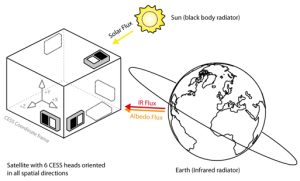Sun sensors play a vital role in satellite attitude control systems, allowing spacecraft to determine their orientation in space relative to the sun. A sun sensor model refers to the specific design or type of sensor developed for unique operational needs, including variations in resolution, sensitivity, and durability. Selecting the correct sun sensor model is essential for mission success, as it enables satellites to maintain accurate positioning throughout their orbit.

Types of Sun Sensor Models
The development of different sun sensor models has enabled tailored solutions for a variety of space missions. Common types include:
- Analog Sun Sensor Model
Analog sun sensors measure the angle of sunlight using continuous signals, providing high-resolution output. This type of sensor is beneficial for applications requiring smooth data transitions, enabling precise adjustments in satellite orientation.
- Digital Sun Sensor Model
Digital sun sensors use discrete signals to convey solar angle information, allowing for rapid data processing. These models are ideal for missions requiring quick response times and can withstand more rigorous conditions, making them reliable for longer missions.
- Fine Sun Sensor Model
Fine sun sensors deliver highly accurate measurements, capturing minute changes in angle to ensure precise orientation. These models are often used in scientific or high-resolution Earth observation satellites, where fine adjustments are essential.
- Coarse Sun Sensor Model
Coarse models provide basic directional data, typically used for initial sun acquisition. Although less precise, they are essential in low-budget missions or as a backup system within a more complex attitude control arrangement.
Choosing the Right Sun Sensor Model for Your Mission
Selecting the correct sun sensor model involves evaluating several critical factors:
- Mission Duration
Missions with extended timelines require durable sensor models with high reliability and radiation tolerance. Digital and fine sun sensor models are often preferred for long-term missions due to their robustness and accuracy over time.
- Required Resolution
For missions involving high-resolution imaging or scientific observations, the fine sun sensor model offers the necessary precision to maintain stable orientation. In contrast, a coarse sun sensor model may be sufficient for simpler missions.
- Environmental Conditions
Spacecraft exposed to extreme temperatures or radiation need sun sensor models with enhanced shielding or material resilience. Models engineered to withstand high-radiation environments are especially beneficial for missions beyond low Earth orbit.
Key Features of Effective Sun Sensor Models
Sun sensor models are designed to deliver consistent performance in the challenging conditions of space. Here are some features that make these models suitable for satellite systems:
- High Sensitivity: Sun sensor models with higher sensitivity capture slight changes in sun angle, aiding in smoother orientation adjustments.
- Radiation Resistance: Models engineered for deep-space missions often include shielding against high radiation levels, enhancing their lifespan.
- Compact Design: Space constraints on satellites make compact sensor models preferable, allowing for efficient use of onboard real estate without sacrificing performance.
Applications of Sun Sensor Models in Satellite Missions
Sun sensor models are widely used in various satellite applications. Some examples include:
- Earth Observation Satellites
Fine sun sensor models are crucial for these satellites, as they require consistent, stable orientation to capture high-resolution images of Earth’s surface.
- Communication Satellites
Communication satellites rely on sun sensors to maintain alignment with ground stations. Digital sun sensor models provide real-time orientation data, ensuring consistent signal strength and quality.
- Scientific and Research Missions
Sun sensor models with high sensitivity and resolution are essential for missions exploring space beyond Earth’s orbit. These sensors help maintain correct positioning, which is critical for telescopic observations and data collection.
Advances in Sun Sensor Model Technology
Ongoing advancements in sun sensor model technology have led to improvements in precision, durability, and efficiency. Key innovations include:
- Enhanced Material Composition: New materials offer improved radiation resistance and temperature stability, extending the operational life of sun sensors in extreme environments.
- Miniaturization: Advances in miniaturization have enabled the development of smaller sun sensor models, allowing them to fit on compact satellite platforms without compromising functionality.
- Improved Data Processing: Enhanced onboard processing within sun sensor models allows for faster data interpretation, enabling satellites to make rapid orientation adjustments with minimal latency.
Selecting the Best Sun Sensor Model for Optimal Satellite Performance
Understanding the needs of a satellite mission is critical for choosing the best sun sensor model. By evaluating mission-specific requirements such as resolution, durability, and environmental compatibility, engineers can ensure that the chosen sun sensor model will support the satellite’s stability and operational goals.
Sun sensor models are foundational elements in satellite attitude control, providing essential data that allow spacecraft to navigate accurately. From basic coarse sensors to highly refined models, sun sensors continue to drive advancements in satellite technology, making them indispensable for a broad range of space missions.
